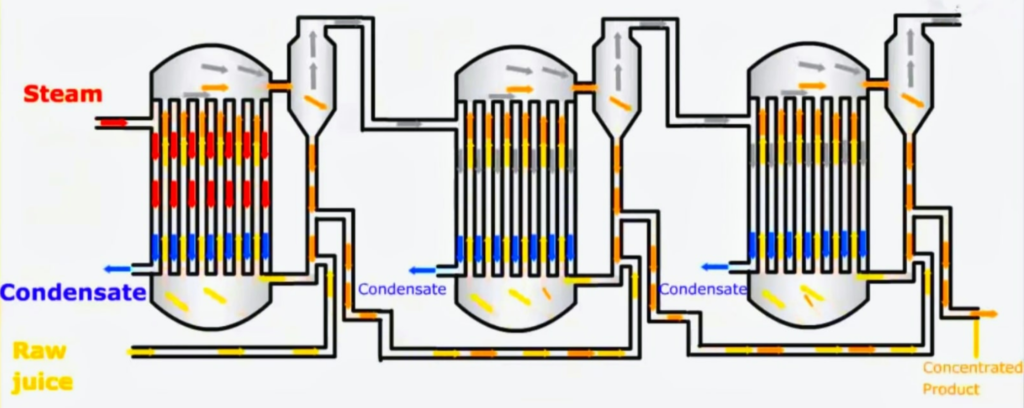1. Principles:
A multiple-effect evaporator is a thermal processing unit designed to efficiently evaporate water or other solvents from a liquid by utilizing the heat from multiple sources. The principle involves the use of multiple evaporator vessels, each operating at a progressively lower temperature and pressure, creating a cascading effect that enhances energy efficiency.
2. Construction:
a. Evaporator Vessels:
– Multiple vessels are connected in series, each serving as a separate stage in the evaporation process.
b. Heat Exchangers:
– Heat exchangers transfer heat from the vapor produced in one stage to the liquid in the next stage, maximizing energy utilization.

c. Vacuum Systems:
– Vacuum systems maintain reduced pressures in each stage, lowering the boiling points and improving efficiency.
d. Condensers:
– Condensers convert the vapor back into liquid, releasing latent heat that can be used in subsequent stages.
3. Working:
1. First Effect:
Liquid is heated in the first vessel, producing vapor.
Vapor is condensed, transferring heat to the liquid in the next vessel.
2. Subsequent Effects:
The process repeats in subsequent vessels, with each stage operating at a lower temperature and pressure.
The heat released during condensation is used to evaporate more liquid in the following stage.
3. Cascading Effect:
The heat cascade from one stage to the next improves overall energy efficiency.
4. Uses:
a. Food and Beverage Industry:
– Commonly used for concentrating fruit juices, milk, and other liquid food products.
b. Chemical Industry:
– Applied in the concentration of chemical solutions, separation, and purification processes.
c. Desalination:
– Utilized in some desalination processes for concentrating brine.
d. Wastewater Treatment:
– Employed in wastewater treatment for concentrating pollutants and reducing liquid volumes.
5. Merits:
a. Energy Efficiency:
– The cascading effect leads to improved energy efficiency compared to single-effect evaporators.
b. Space Utilization:
– Multiple-effect evaporators allow for the concentration of large quantities of liquid in a relatively compact space.
c. Reduced Operating Costs:
– Operating costs are lower due to energy recovery from one stage to the next.
6. Demerits:
a. Initial Cost:
– The initial installation cost is higher compared to single-effect evaporators.
b. Complexity:
– Multiple-effect evaporators are more complex in design and operation, requiring skilled maintenance.
c. Sensitivity to Fouling:
– Sensitive to fouling, and regular cleaning is necessary to maintain efficiency.
d. Limited Versatility:
– May not be as versatile as some single-effect evaporators for certain applications.
Economy of Multiple Effect Evaporator
1. Energy Savings:
The main economic advantage lies in energy savings. The heat cascade allows the reuse of latent heat, reducing the overall energy consumption for evaporation.
2. Reduced Operating Costs:
Lower energy requirements result in reduced operating costs over the long term.
3. Higher Production Rates:
Multiple-effect evaporators enable higher production rates compared to single-effect units, contributing to increased overall efficiency and profitability.
4. Investment Payback:
While the initial investment is higher, the payback period can be relatively short due to ongoing energy savings.
5. Sustainability:
The improved energy efficiency contributes to environmental sustainability by reducing energy consumption and greenhouse gas emissions.
6. Process Integration:
Multiple-effect evaporators can be integrated into larger processing systems, enhancing overall process efficiency and economy.
Multiple-effect evaporators offer significant economic advantages in terms of energy savings, reduced operating costs, and higher production rates. While the initial investment may be higher, the long-term benefits make them a cost-effective and sustainable solution for concentration and evaporation processes in various industries. Understanding both the merits and demerits is crucial for making informed decisions about their implementation in specific industrial applications.

